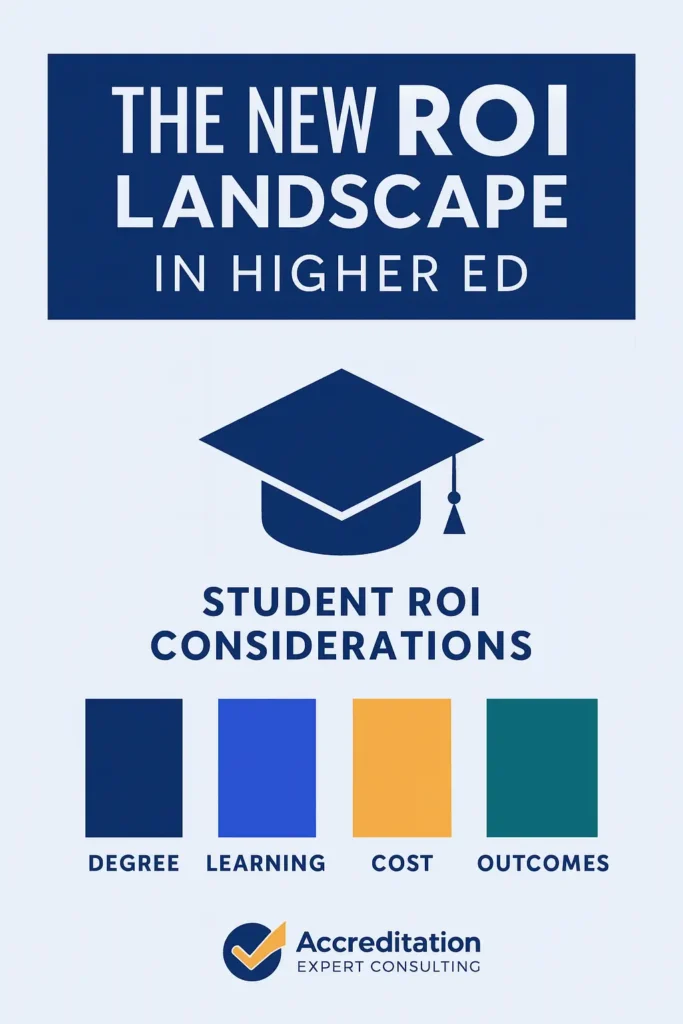
Higher education is facing a reckoning. Across the country, students and families are asking a blunt question: Is this degree worth it? With tuition rising, student debt ballooning, and post-graduation earnings uncertain, the return on investment (ROI) of college has become the new bottom line. In a post-pandemic, AI-powered economy, students aren’t just looking for prestige; they’re demanding proof of value.
This article explores how ROI pressures are changing the way institutions design, measure, and communicate the worth of their programs. For academic leaders, the message is clear: rethinking value is no longer optional; it’s an urgent matter of enrollment strategy, state authorization, and long-term institutional survival.
Why the ROI Conversation Matters Now
Declining Confidence in the Degree
Recent surveys indicate that public confidence in the value of a college education is declining. According to a 2024 Gallup poll, only 36% of U.S. adults say a college education is “very important,” down from 70% a decade ago. Enrollment numbers reflect this shift, with many institutions seeing continued declines, especially among first-generation and working adult students.
Shifting Student Expectations
Today’s students want:
- Clear career pathways
- Measurable learning outcomes
- Flexible, skills-focused credentials
- Transparent data on costs, earnings, and placement rates
This isn’t just a marketing issue. It’s a challenge of accreditation consulting for colleges , curriculum design, and cross-departmental alignment.
The Pressure to Demonstrate Value
Accreditors Are Paying Attention
Accrediting bodies are placing more emphasis on institutional effectiveness, not just compliance. That means schools must:
- Define and track student learning outcomes
- Align course objectives with workforce competencies
- Use data dashboards to monitor academic ROI
State Agencies Want Justification
When seeking approval for new university programs, state licensing agencies increasingly require:
- Labor market alignment evidence
- Employer support letters
- Projected student earnings data
- Cost-benefit justifications for prospective students
Learn how our state licensing support helps institutions pass scrutiny and accelerate approval timelines.
A New Definition of Institutional Value
From Input-Focused to Outcome-Driven
Old metrics like student-faculty ratios and campus size are giving way to:
- Graduate employability
- Earnings vs. debt ratios
- Skill mastery and stackable credentials
- Student satisfaction linked to measurable gains
“According to the U.S. Department of Education, schools that report strong outcome data are more likely to receive approval for federal financial aid.” Source
Students as ROI Evaluators

Prospective students now act like investors, comparing programs based on:
- Cost-per-credit
- Internship and job placement rates
- Alumni testimonials and salaries
- Program accreditation status
Explore our accreditation services to make your outcomes more competitive and visible.
Strategies to Rethink and Improve ROI
1. Start with Curriculum Redesign
- Audit programs for relevance to high-demand fields
- Map learning outcomes to industry certifications
- Build faster pathways to graduation
2. Use Transparent Data Tools
- Publish earnings vs. cost comparisons
- Visualize ROI with infographics, not just text
- Segment data by program and population
Click here to download the Beyond Grades Assessment Toolkit for evaluating and communicating ROI effectively.
3.Engage Students in the Value Process
- Collect and act on alumni outcome data
- Include student input in program reviews
- Make career services a core academic partner
Our enrollment strategy consulting helps align your value story with the expectations of prospective students.
The New ROI Landscape in Higher Ed

Frequently Asked Questions
How can smaller colleges compete on ROI without major endowments?
Focus on outcomes. Highlight career placement success, alumni impact, and program-specific ROI. Use data visualization to build credibility
Do accreditors penalize schools with low graduate earnings?
Not directly. But failure to assess and improve outcomes can lead to compliance risks and probationary status.
What types of data should be shared with students during recruitment?
Job placement rates, median graduate salaries, loan repayment success, and skill-based outcomes aligned with real roles.
Can ROI be improved without cutting tuition?
Yes. Streamlining time-to-completion, embedding certifications, and aligning curriculum with high-growth fields are proven ROI boosters.
What are the top mistakes schools make when reporting ROI?
Using outdated data, hiding poor outcomes, or failing to contextualize program-level metrics.
Ready to build smarter systems that meet compliance and grow enrollment?
Schedule a free consultation or download our free toolkit today.
📧 info@AccreditationXpert.com
📞 1-833-232-1400
🌐 www.AccreditationXpert.com (That’s X-P-E-R-T)




